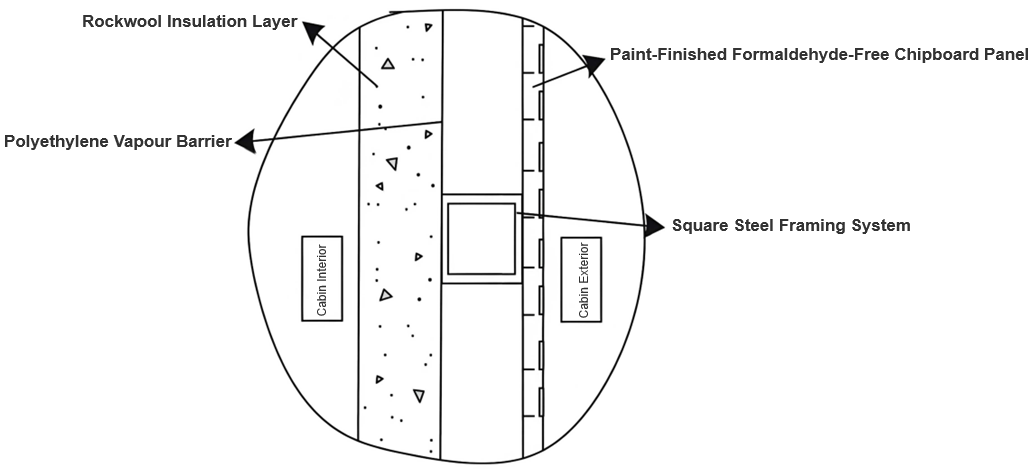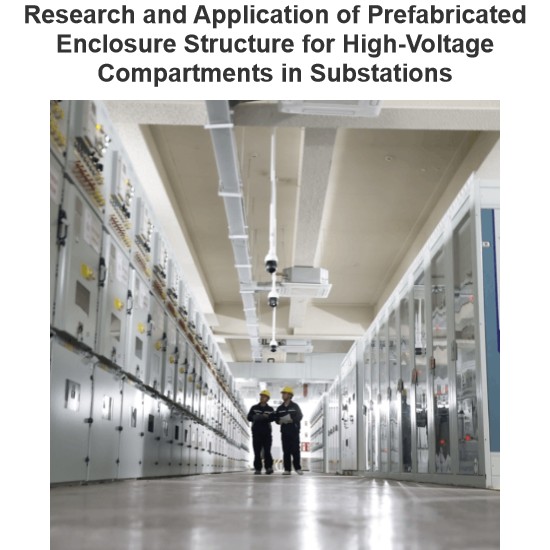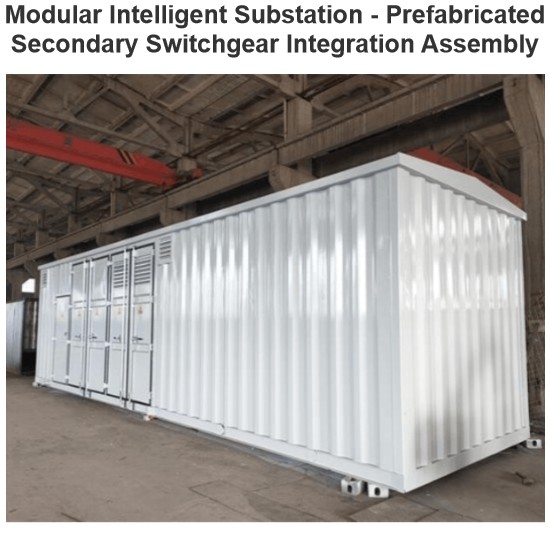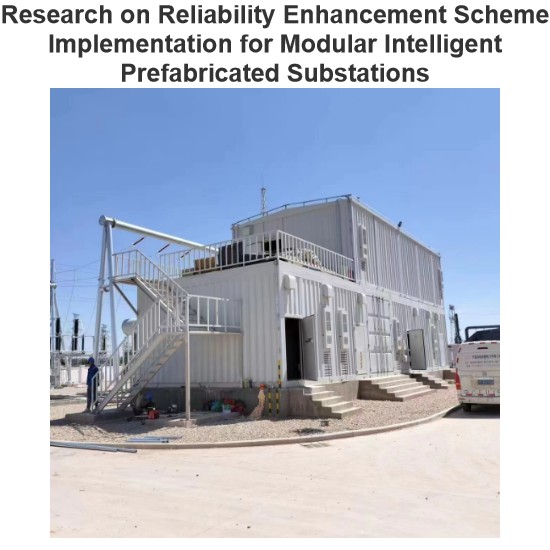Under global climate diversity, alpine power construction faces technical and environmental challenges. Extreme climates, complex geology, and long - term low winter temperatures, along with ice, snow, and storms, strain electrical equipment stability and power facility construction (schedule, cost, maintenance). Traditional on - site substations, with long construction and poor adaptability, can’t meet alpine regions’ fast, stable power needs.
Prefabricated cabin substations, as modular, factory - prefabricated setups integrating core equipment (high - voltage switches, transformers, control systems), enable quick on - site assembly after transport. They cut environmental dependence, showing unique value in harsh, time - tight alpine areas. This research aims to boost alpine power system upgrades and global similar - environment power development.
Project Overview
The project sits in a southwest China alpine region: - 8°C average annual temp, - 30°C winter lows, 5 + months of ice - snow, over 1m ground freeze. At 3600m altitude, it covers 6000m2(1200m2) built area), with ¥55 million total investment (¥33 million for equipment, ¥22 million for construction).
It has 2×120MVA main transformers (meeting winter high load), 8×10kV distribution cabinets (for power distribution), and 3km low - smoke, anti - freeze cables (suited to cold). With an 8 - month design - construction cycle, it aims to ensure stable, reliable power under extreme conditions.
Laying Frost - proof Soil Layer
Alpine cold and freeze - thaw cycles risk soil freezing, endangering substation foundations and cabins. To address this, GCL (thermal conductivity < 0.5W(m·K), good insulation) is used. The 0.8m - thick layer prevents frost heave.
For extreme cold: first, a CAT 336E excavator removes frozen/polluted topsoil. Then, 5–20mm gravel replaces it (300mm thick) to boost bearing capacity and drainage. A 400mm - thick double - layered GCL (≥200mm lap, checked for gaps) follows. A 100mm - thick, 5–15mm gravel protection layer tops it to shield GCL during use.During construction, the layer is rolled in 200mm - thick sections, with ≥6 passes. Quality standards are in Table 1

Key Points of Frost - Proof Soil Layer Construction
During the construction of the frost - proof soil layer for prefabricated cabin substations in alpine regions, the following key aspects need to be strictly controlled:
- Temperature Control: The ambient temperature during construction should be maintained above -10°C to avoid soil freezing, which may affect the construction quality.
- Drainage Assurance: Strengthen the drainage facilities at the construction site to prevent construction water from soaking the frost - proof soil layer and damaging the soil structure.
- Construction Schedule Planning: Scientifically arrange the construction progress and avoid winter construction. Because low temperatures in winter are likely to cause frost - related problems in the soil, strictly follow the construction sequence to ensure the supporting effect of the frost - proof soil layer on the stability of the substation foundation.
Thermal Insulation Design of Cabin Structure
Under the severe cold climate in alpine regions, the temperature inside the cabin may drop to below -30°C, posing a severe challenge to the stable operation of the equipment in the substation. Therefore, a systematic thermal insulation design is required to maintain a stable internal environment of the cabin:
Key Points of Frost - Proof Soil Layer Construction
During the construction of the frost - proof soil layer for prefabricated cabin substations in alpine regions, the following key aspects need to be strictly controlled:
- Temperature Control: The ambient temperature during construction should be maintained above -10°C to avoid soil freezing, which may affect the construction quality.
- Drainage Assurance: Strengthen the drainage facilities at the construction site to prevent construction water from soaking the frost - proof soil layer and damaging the soil structure.
- Construction Schedule Planning: Scientifically arrange the construction progress and avoid winter construction. Because low temperatures in winter are likely to cause frost - related problems in the soil, strictly follow the construction sequence to ensure the supporting effect of the frost - proof soil layer on the stability of the substation foundation.
Thermal Insulation Design of Cabin Structure
Under the severe cold climate in alpine regions, the temperature inside the cabin may drop to below -30°C, posing a severe challenge to the stable operation of the equipment in the substation. Therefore, a systematic thermal insulation design is required to maintain a stable internal environment of the cabin:
(1) Selection and Structure of Thermal Insulation Materials
- Exterior Facade Maintenance: A 15mm - thick FC (Fiber Cement) panel is selected, which has both strength and durability and serves as the "protective shell" of the cabin.
- Main Thermal Insulation Layer: Leveraging the advantage of the high thermal resistance of rock wool, a 50mm - thick phenolic rock wool sandwich panel is installed inside the cabin to form a "thermal barrier".
- Moisture - Proof Enhancement: A polyethylene moisture - proof film is embedded between the FC panel and the rock wool panel to block the penetration path of external moisture, keep the interior of the cabin dry, prolong the service life of the thermal insulation layer, and improve the structural stability of the cabin.
(2) Optimization of Installation Process
The purlin - free dry - hanging technology is adopted to connect the FC external wall panel, the rock wool panel, and the square steel keel. Special hangers and fasteners are used to tightly combine the thermal insulation layer with the structural framework. This measure realizes the seamless continuity of the thermal insulation layer, avoids the thermal bridge effect (heat loss through heat - conducting parts such as the metal framework), and improves the overall thermal insulation efficiency.
(3) Sealing Detail Treatment
For the tongue - and - groove of the rock wool sandwich panel, foamed polyurethane with a density of ≥30kg/m³ is used for filling and sealing. With its characteristics of plasticity, airtightness, high strength, and non - water absorption, this material forms a highly efficient sealing environment at both ends of the sandwich panel (with a thermal conductivity of ≤0.024W/(m·K) ), greatly reducing heat loss at the joints, ensuring the thermal insulation performance of the cabin in the alpine environment, and laying a solid foundation for the reliable operation of the prefabricated cabin substation in extreme climates.
Heating Cable Installation
When an electric current passes through the heating cable, its electrical resistance converts into heat, thereby warming the surrounding environment. For prefabricated substation cabins in alpine regions, heating cables with a power rating of 20–30W/m are selected. This power level ensures sufficient heat output to maintain the internal temperature within a safe operating range for electrical equipment.
Prior to installation, a detailed thermal assessment is conducted using Fourier's Law of Heat Conduction to calculate the heating requirements for critical components and pipelines. The mathematical formula is as follows:
In heat conduction calculations:
- Q: Required heat (unit: W)
- k: Thermal conductivity of equipment surface material (unit: W/m·K)
- A: Heat conduction area (unit: m2)
- ΔT: Required temperature difference (unit: K)
- d: Thickness of heat conduction path (unit: m)
For heating cable installation:
- Fixing: Use high - strength clamps (e.g., stainless steel clips, plastic straps) to secure cables to equipment surfaces/pipelines, with clamp spacing ≤ 30 cm to prevent displacement and ensure stable heat transfer.
- Layout Density: Arrange cables at 10 cm intervals in trenches and on critical equipment to provide sufficient heat and prevent icing.
- Temperature Control: Use K - type thermocouples to monitor cable operation in real - time. Pair with PID (proportional - integral - derivative) algorithms to auto - adjust power output, maintaining temperature within required ranges. The PID formula is shown in Equation (2).

Ventilation Device Layout
In alpine regions, extremely low winter temperatures can affect substation equipment (e.g., transformers, switchgear) and overall stability. Thus, 4 axial fans (1.5 kW, (2000 m3/h) are symmetrically installed on side walls to ensure uniform air flow and prevent condensation.
For prefabricated cabin substations, a “top intake, bottom exhaust” ventilation design is used. The area ratio of intake to exhaust outlets is 1:1.5 to ensure sufficient air changes. Insulated ducts (50 mm rock wool, 0.035 W/(m·K) thermal conductivity) with 0.5 mm aluminum foil wrapping reduce heat loss and maintain stable indoor temperatures.
Dual - Power Supply
To adapt to alpine climates, two S13 - M - 100/10 oil - immersed transformers (100 MVA, 10/0.4 kV) are used as main transformers. Connected to independent power sources, they operate in parallel (50% load rate under standard conditions) to reduce losses and extend service life. The SCADA system monitors and balances loads in real - time.
In emergencies (e.g., one transformer fails), the ATS switch completes power transfer within 0.1 s, ensuring seamless load takeover and stable power supply. As per GB 50052 - 2009, two DKSC - 100/10 reactors (100 A, 6% reactance) limit short - circuit current to ≤ 20 kA, preventing overvoltage damage.
Conclusion
Alpine regions’ extreme conditions (low temps, wind, snow) demand higher standards for prefabricated cabin substation operation and maintenance. Design and construction must include suitable insulation, heating, moisture - proof measures, and wind - snow - resistant equipment.
Future advancements in technology and practice will further optimize these substations. Intelligent monitoring and dispatching systems will enhance remote management and adaptability to extreme climates, ensuring stable and safe power supply.

















